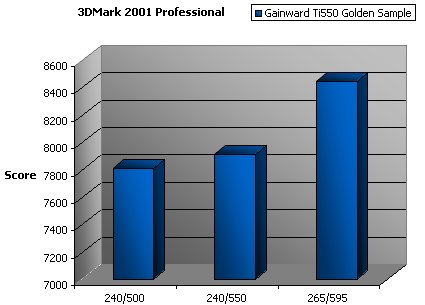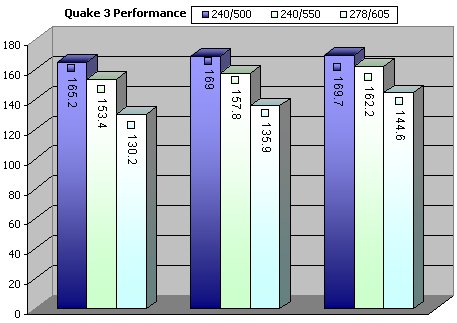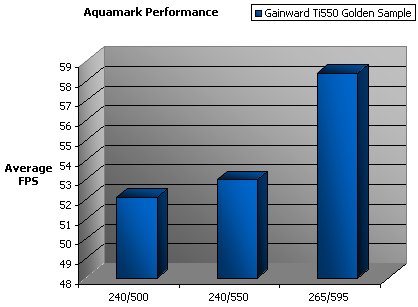|

Introduction
We've had a look at a fair few NVIDIA based cards recently what with a look at a pair of GeForce2 Ti boards from Sparkle and Prolink and a look at Hercules' Ti500 based card and it's with the Ti500 GPU that Gainward have based this new card around.
However, being Gainward it was somewhat inevitable that they put their own spin on things. They are quite famous for their Golden Sample cards that run quicker than the reference rated speeds provided by NVIDIA and many a buyer has been swayed towards a Golden Sample card due to this out of the box advantage.
Before we go any further with the card itself, if you'd like a refresher on the Ti500 GPU or GeForce3 cards in general, Chris did an excellent job with the review of the Hercules Ti500 and covered all the bases with regards to GPU features, technical information and overview of the GPU and it's iterations. Take a look at that review here.
Being a Gainward, as well as going a bit further with the clock speeds they also go a bit further than the norm in almost all areas. The PCB is a striking red colour, along with the memory heatsinks and the GPU cooler making it a standout card if showing off your computer is your thing.
The card also features, like the original GeForce3 Golden Sample (reviewed here), a DVI port and TV-Out functions so you have a wide range of connection options out of the box ranging from lowly television output to super high end DVI-enabled TFT flat panel.
Sadly, unlike it's original sibling, the Ti550 doesn't feature video in functions which the original card provided via a daughter card with Philips SAA7108E processor. Only TV-Out features on the Ti550 which might be a turn off for some as I certainly made use of it.
Finally, going back to the Golden Sample aspect of things and taking a look at the name of the card, you can see that this card goes a bit further than the stock Ti500 clock speeds. Core speed is unchanged at 240Mhz however the memory clock is now adjustable to 550Mhz (275Mhz DDR) using the supplied Gainward utility. Most Ti500's will do 550Mhz memory clock however Gainward has extra faith in all its Golden Sample cards and actively encourages you to run the card at the quicker clock speed. The card BIOS boots the card at 240/500 however, so initially, the card is the same speed as any other Ti500.
The cards have a reputation of being solid overclockers, often going well beyond the rated specification and we'll take a good look at that later in the review. Lets take a look at the official specification before moving on to performance.
Specification
Hardware
NVIDIA GeForce3 Ti 500 GPU, 256-bit 2D & 3D graphics architecture
Support AGP 2X/4X
Memory size up to 64MB with ultra fast DDR SDRAM
Support high resolution up to 2048x1536@75Hz
Build-in 350MHz RAMDAC with gamma correction
NTSC / PAL TV-Out with flicker filter
TV-Out resolution up to 800x600
Support Composite & S-Video TV-Out
DirectX and S3CT texture compression
nfiniteFX engine for full programmability
Lightspeed Memory Architecture for unmatched performance
Surface engine for high-order surfaces and patches
Programmable Vertex Shader
Programmable Pixel Shader
HRAA-high-resolution antialiasing
Integrated hardware transform engine
Integrated hardware lighting engine
Dual cube environment mapping capability
Hardware accelerated real-time shadows
Support LCD output with DVI connector up to 1600x1200(optional)
High-quality HDTV / DVD playback
High-definition video processor (HDVP) for full-screen, full-frame video playback of HDTV and DVD content
Independent hardware color controls for video overlay
Hardware color-space conversion (YUV 4:2:2 and 4:2:0)
Per-pixel color keying
Multiple video windows supported for CSC and filtering
DVD sub-picture alpha-blended compositing
Compatibility
Windows 2000 / NT (all) / 9x / ME / XP
OpenGL 1.2 and lower
DirectX 8.X
NVIDIA Unified Driver Architecture
Fully-compliant OpenGL 1.2 in all Windows operating systems
The card is feature rich and highly compatible. It's nice to see explicit support for NT4 here since many manufacturers dont consider NT4 to a be a good gaming operating system and this is ostensibly a gamers card, however a large range of games work perfectly well, the majority being OpenGL based for which NT4 has always been a solid platform.
The DVD playback features of the card also feature prominently despite the NVIDIA being unloved by the masses when it comes to DVD playback. The HDTV features aren't much use, at least not here in the UK where HDTV is yet to take hold however having proper explicit support is never a bad thing!

Card Installation and Drivers
Card installation couldn't have been simpler. Since the operating system was reinstalled for this review it was just a matter of removing the old graphics card and slotting in the Ti550 and screwing it in. On an existing operating system installation it would just have been a matter of removing the old cards drivers, swapping cards and rebooting.
The drivers used were DetonatorXP 22.40 drivers and are the same drivers we've used for a couple of months. Installation via device manager was a simple matter of pointing the driver wizard to the directory where the drivers were located. The wizard then copies them to the correct location and the device is initialised. On WindowsXP this doesn't even require a reboot for me.
Performance
We'll take a look at performance in 3 ways, a bit differently from usual. Usually we look at stock and overclocked performance but this time we spent a bit more time looking at 3 levels, 240/500, 240/550 to see what effect the overclocked memory has and then some proper overclocking taking things a fair bit further.
We'll also try something different and not take a look at them in turn but give you graphs with the 3 results and clocks for each benchmark we use and discuss all 3 results at once. Hopefully that lets us compress things a bit more while still giving you all the information you need. Let me know if it works for you!
Firstly, the test system.
- Gainward GeForce3 PowerPack !!! Ti/550 Golden Sample
- Soyo Dragon Plus KT266A Motherboard
- AMD Athlon XP1800 Processor
- 256Mb Crucial PC2100 CAS2.5 DDR memory @ CAS2
- Adaptec 39160 PCI SCSI Dual Channel U160 controller
- 2 x 73Gb Seagate Cheetah U160 10,000rpm SCSI disks
- Plextor 12/10/32S SCSI CDRW
- Soundblaster Audigy
- Windows XP Professional Build 2600.xpclient.010817-1148
- DetonatorXP 22.40 NVIDIA drivers
- Aquamark v2.3
- Quake3 v1.30
- 3DMark 2001 Professional
- Unreal Tournament Build 436
First off, we'll start with 3DMark 2001 Pro. It's the benchmark everyone loves to see and probably the biggest indicator of performance that everyone can relate to.

The 50Mhz increase in the memory clock gives us roughly a 100 point (just over infact) increase. This is standard stuff with regards to 3DMark on this type of platform, especially with a GF3 based graphics card like we have here. You espect a 1 to 2 point increase per 1Mhz increase on the memory clock with such a card. However, with the increase in core and memory clock like we see in the 3rd graph entry, we get a further 530 point increase. A combination of core and memory clock increases are the key to high 3DMark scores.
Also, it's worth noting that it was a straight run at the highest clocks possible. Depending on the test, you can usually adjust the clocks a bit higher. On GeForce3 hardware and to a certain extent GeForce2 cards, High Detail Dragothic is the hardest on the card. For this review, the 265/595 clock is the quickest clock able to complete all tests and any higher and the card dies on High Dragothic. The Nature test for example on this card completes without artifacts at 285/613.
It shows the card can go a bit higher depending on the work it is doing and we'll see that in our other benchmarks.
Next up we have Quake 3. Q3 with the v1.30 Point Release installed is our OpenGL benchmark from the group. It's a fairly old benchmark at the moment as the performance figures are going to show us. The engine runs incredibly fast on current hardware. Remember that when testing, all performance sapping features are enabled giving the card the most possible work to do. Options enabled include 32-bit colour rendering and 32-bit textures and we use Q3Bench to run the tests.

Here we see a rough increase of about 4 frames per second across all resolutions from our initial increase in memory clock to the Ti550 speeds. Nothing exciting but the performance is free. However the jump to the highly overclocked speed of 287/605 shows us a few things. Performance increase at 1024x768 shows us that we are CPU limited at that resolution. The new clocks make no dent in the performance at 1024x768 meaning that we need a CPU speed increase to get any more performance at 1024x768.
As we move up to 1280x1024 and then 1600x1200 we see that as the fillrate required by the card increases, the 1533Mhz processor doesn't become the limiting factor and the card clocks have a decent effect on performance. This is most observable at 1600x1200 where the required card fillrate is high and the increase in memory clocks giving higher memory bandwidth are helping. Increasing the core clock of the card has little effect since the card GPU is fast enough to process the information, it just needs to be given the information quicker due to higher memory bandwidth.
Worth nothing is the performance baseline of the results at all card clocks. 130.2fps was the slowest measured and that was at 1600x1200 with all performance options on. This means that resolution is imminently playable and is a valid gaming resolution. Performance in Quake 3 on current hardware is playable at all common resolutions. Time for a new test?
Next up, Unreal Tournament. Again, like Quake 3 the engine is fairly old and runs terrifically on current hardware. It's very CPU limited as we'll see with high card clocks doing very little for performance. Not the greatest of video card benchmarks I'm afraid.

The performance delta across all card clocks and all resolutions is less than 6 frames per second. All of the rendering performance in UT comes from the host processor since UT spends a lot of time on the CPU doing calculations for the world objects (actors in UT-speak) such as lighting and physics. So if you are looking for more UT performance then consider a CPU upgrade or CPU overclock before looking to your graphics card.
Finally, we have Aquamark. It uses DirectX 8 for it's rendering and makes good use of the new features that came with version 8 of the multimedia API. This means a DX8 class render target like the GeForce3 (remember, the new features were licensed to Microsoft by NVIDIA) is required for the best performance. Above around 45fps is decent performance in Aquamark so that's what we are aiming for. Also increased card clocks should show discernable performance increases unlike Unreal Tournament. It's a good full system test with card clocks and CPU clock/front side bus all having an effect on the final score.

You'll notice that the origin of the graph is 48fps to enhance the effect the graph has. You can see the increase to 550Mhz memory gives less than 1fps increase. This shows us that increased memory bandwidth, whilst increasing performance, isn't the most important factor. The GPU is worked extremely hard in Aquamark as the program is very heavy on its usage of pixel and vertex shaders for the effects. Therefore increased core clock on the Gainward should give us a decent increase in performance. This is what we see in the final column representing the highly overclocked values of 265/595. Performance increases roughly 11% with the maximum overclocked speeds we attained. The clocks used were able to loop Aquamark without any problems are were perfectly stable.
Performance Conclusion
It's quite clear that the card offers excellent performance out of the box in both 240/500 and 240/550 guises but it really shines when the speeds are pushed a bit further. The memory clock was able to be pushed to at least 595Mhz in all benchmarks and at least 265Mhz on the core clock was doable with often quite a bit more. The card is highly overclockable and given decent cooling could maybe go higher. The card was stock cooled throughout with only a case fan near the card helping to draw the hot air away which is slightly worse than blowing cold air over it.
Massive performance is easily obtainable and the standard clocks look fairly conservative. It seems like Gainward have given us a golden sample this time. Untweaked out of the box performance is more than a match for any game at 1024x768 resolution given the correct base platform.
Conclusion
We're big fans of the GeForce3 here at Hexus. It's a fast GPU with excellent features and runs all current games very well. The Ti500 version further increases performance and Gainward have taken it that little bit further. The core card features are solid with DVI and TV-Out both very welcome. TFT panels continue to increase in popularity and decrease in price and their adoption becomes more widespread. The Ti/550 Golden Sample gives you pure digital output at up to 1600x1200 on compatible panels.
TV-Out, while not tested extensively was fine and gaming at 800x600, the maximum resolution, was very fast with no complaints. DVD playback, while not up to the quality of out test ATi Radeon 8500 was acceptable and very watchable. The card also stands out with it's red colouring and decent bundle.
It's not quite as fast as ATi's R8500 but when the performance is at the levels we saw here, you start to consider more than raw frames per second. With either card running all games out today at extremely playable speeds, the Gainward relies more on it's other features to stand out.
It's a shame that full VIVO capability couldn't be added to the card since that would give it an added edge. As it stands, I'm not sure if the Radeon 8500 is beaten just yet. However, you don't really go wrong with either card provided you can afford it.
Komplett (Komplett.co.uk) are carrying the card in stock at the moment for £303 inc VAT which is expensive for a graphics card, even in the high end, but you get what you pay for.
Overall, a very high performance graphics card with excellent core features at a high price. Not quite a Radeon 8500 killer performance wise but very close in the real world. Top marks to Gainward and hopefully it will stay in my system for a little while longer!
|